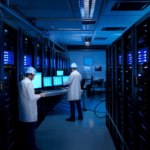“`html
The Intersection of AI and Computer Vision: Innovations You Need to Know
Introduction
Artificial Intelligence (AI) and Computer Vision are two rapidly advancing fields that have revolutionized the way we interact with technology. AI refers to the simulation of human intelligence processes by machines, especially computer systems. These processes include learning, reasoning, and self-correction. Meanwhile, Computer Vision is a subset of AI that focuses on enabling machines to interpret and understand visual data from the world. Together, AI and Computer Vision form a powerful synergy that is transforming industries ranging from healthcare to autonomous vehicles.
The importance of their intersection lies in the ability to process vast amounts of visual data efficiently and accurately. This collaboration has led to significant advancements in technology, making it possible to automate tasks that were previously only achievable through human intervention. As both fields continue to evolve, their integration promises even more groundbreaking innovations, making them indispensable tools for the future.
Understanding AI and Computer Vision
Defining AI
Artificial Intelligence (AI) encompasses a broad range of technologies designed to simulate human intelligence. It involves creating systems capable of performing tasks that typically require human intelligence, such as problem-solving, decision-making, and understanding natural language. Over the years, AI has evolved from simple rule-based systems to complex machine learning algorithms that can learn from data and improve over time.
Defining Computer Vision
Computer Vision is a specialized area within AI that focuses on enabling machines to interpret and understand visual information from the world. This involves developing algorithms that can process images and videos to extract meaningful information. For example, a computer vision system might be able to identify objects in an image, track movements, or recognize faces. The field draws heavily on techniques from signal processing, pattern recognition, and machine learning.
Historical Context
The roots of AI and Computer Vision can be traced back several decades. Early work in AI focused on symbolic reasoning and expert systems, while early efforts in Computer Vision involved basic image processing techniques. However, it was the advent of deep learning and neural networks that truly propelled both fields forward. Today, these technologies are at the forefront of innovation, driving advancements in everything from autonomous vehicles to medical diagnostics.
Key Technologies Driving the Intersection
Deep Learning and Neural Networks
Deep learning is a subfield of machine learning that uses neural networks to model complex patterns in data. These networks consist of layers of interconnected nodes that process information in a hierarchical manner. By training these networks on large datasets, they can learn to perform tasks such as image classification, object detection, and facial recognition with remarkable accuracy.
Convolutional Neural Networks (CNNs)
Convolutional Neural Networks (CNNs) are a type of deep neural network specifically designed for processing grid-like data such as images. They are particularly effective for tasks involving image and video recognition because they can automatically and adaptively learn spatial hierarchies of features from input images. CNNs are widely used in applications ranging from medical imaging to autonomous driving.
Edge Computing and Cloud-Based Solutions
Edge computing and cloud-based solutions play a crucial role in enhancing the real-time processing capabilities of AI and Computer Vision systems. Edge computing allows data to be processed closer to where it is generated, reducing latency and improving response times. On the other hand, cloud-based solutions provide scalable infrastructure for storing and processing large volumes of data, enabling more sophisticated analyses and predictions.
Applications of AI and Computer Vision
Healthcare
In healthcare, AI and Computer Vision are being used to analyze medical images such as X-rays, MRIs, and CT scans. These technologies can help radiologists detect abnormalities more accurately and quickly, potentially leading to earlier diagnoses and better patient outcomes. For instance, AI-driven image analysis systems can assist in identifying tumors, fractures, and other conditions that might otherwise go unnoticed.
Autonomous Vehicles
The automotive industry is one of the most prominent beneficiaries of AI and Computer Vision. Autonomous vehicles rely heavily on these technologies to navigate roads safely. Object detection and tracking systems powered by AI and Computer Vision enable cars to recognize pedestrians, cyclists, and other vehicles, allowing them to make split-second decisions to avoid collisions.
Retail
In retail, AI and Computer Vision are being used to enhance inventory management and customer experience. Systems equipped with these technologies can automatically count stock levels, monitor shelf arrangements, and even track customer behavior within stores. This information can be used to optimize layouts, improve product placement, and personalize marketing efforts.
Security
Facial recognition and surveillance systems powered by AI and Computer Vision are increasingly being deployed in public spaces and private buildings for security purposes. These systems can identify individuals, track their movements, and alert authorities in case of suspicious activities. While these technologies offer enhanced security, they also raise important ethical considerations regarding privacy and civil liberties.
Emerging Applications
In addition to traditional applications, AI and Computer Vision are finding new roles in emerging fields such as augmented reality (AR), virtual reality (VR), and robotics. AR and VR systems use these technologies to overlay digital information onto the physical world, creating immersive experiences for users. Robotics, on the other hand, benefits from AI and Computer Vision to enable robots to perceive and interact with their environment more effectively.
Challenges and Ethical Considerations
Data Privacy Concerns
One of the primary challenges facing AI and Computer Vision is ensuring the privacy and security of personal data. As these technologies become more prevalent, there is a growing concern about how data is collected, stored, and used. It is essential to implement robust data protection measures to prevent unauthorized access and misuse of sensitive information.
Bias in Algorithms
Bias in algorithms is another significant issue that needs to be addressed. If the data used to train AI models is biased, the resulting systems may perpetuate or even exacerbate existing inequalities. Developers must take steps to ensure that their models are trained on diverse and representative datasets to minimize the risk of bias.
Transparency and Accountability
Ensuring transparency and accountability is crucial for building trust in AI and Computer Vision systems. Users need to understand how these systems work and be confident that they are making fair and accurate decisions. This requires developing clear guidelines and standards for testing, validating, and auditing AI models.
Ethical Implications
The use of AI and Computer Vision in sensitive areas such as surveillance and healthcare raises important ethical questions. For example, facial recognition systems may be used to monitor individuals without their consent, raising concerns about privacy and civil liberties. Similarly, AI-driven diagnostic tools must be carefully evaluated to ensure they do not lead to misdiagnoses or inappropriate treatments.
Future Trends and Innovations
Improved Accuracy and Efficiency
Looking ahead, one of the key trends in AI and Computer Vision will be the continued improvement in the accuracy and efficiency of models. Researchers are exploring new architectures and training techniques to develop more powerful and efficient algorithms. These advancements will enable systems to handle larger datasets and more complex tasks with greater precision.
Integration with Emerging Technologies
Another important trend is the integration of AI and Computer Vision with other emerging technologies such as the Internet of Things (IoT) and 5G. The combination of these technologies will enable real-time data exchange and processing, opening up new possibilities for applications in smart cities, industrial automation, and beyond.
Potential Breakthroughs
Researchers are also actively working on breakthroughs in unsupervised learning and generative models. Unsupervised learning aims to enable machines to learn from unstructured data without explicit labels, while generative models can create new data that resembles the training data. These advancements could lead to significant improvements in areas such as image synthesis, anomaly detection, and predictive maintenance.
Ongoing Research
There is a wealth of ongoing research in AI and Computer Vision, with many promising avenues for exploration. Some of the most exciting areas include multi-modal learning, which combines different types of data (e.g., text, images, audio) to improve understanding; explainable AI, which seeks to make AI models more transparent and interpretable; and federated learning, which allows models to be trained across multiple devices while preserving privacy.
Conclusion
The intersection of AI and Computer Vision represents a powerful force for innovation, with far-reaching implications for numerous industries. From healthcare to autonomous vehicles, these technologies are transforming the way we live and work. As we move forward, it is essential to address the challenges and ethical considerations associated with their use. By doing so, we can ensure that these advancements are leveraged for the benefit of all.
We encourage readers to stay informed about new developments in these fields and to participate in the ongoing conversation about the future of AI and Computer Vision. The potential for innovation is immense, and by staying engaged, we can help shape a future where these technologies are used responsibly and ethically.
“`


